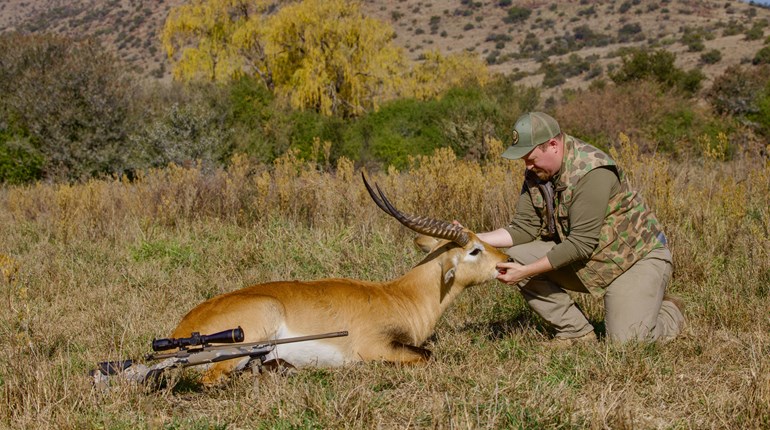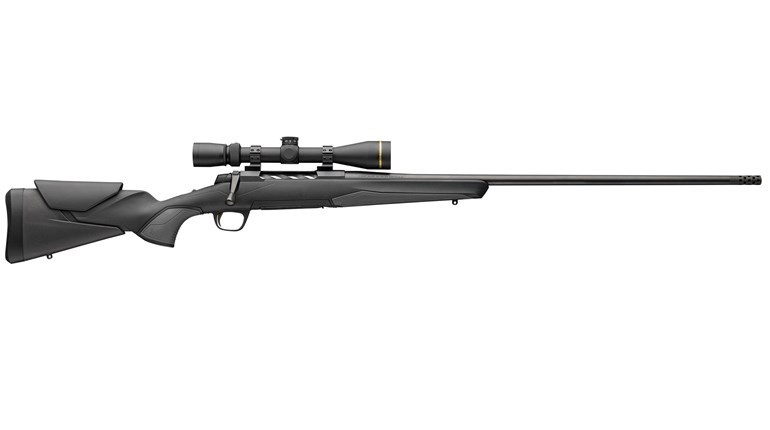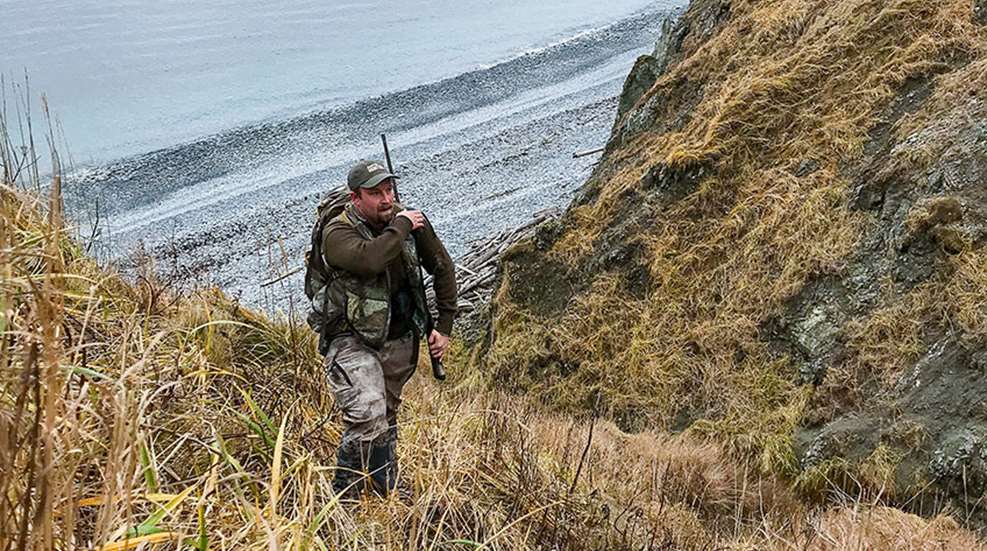
The truth is, a real Kodiak Island adventure lies somewhere between a good idea and a near-death experience. Success on such a journey isn’t measured by the tags you fill, but by the limits you push past as you walk a tightrope through the precarious gray area in between.
■ ■ ■
It seemed like a good idea at the time. I mean, we were hunting Sitka blacktail, and here, not 50 yards and standing broadside, was a dandy—think fast. I didn’t, and the buck bolted. But when he stopped again at 250, Steve’s assurance that this was in fact a shooter—even on day one—well, that was enough for the hunter in me to hunt.
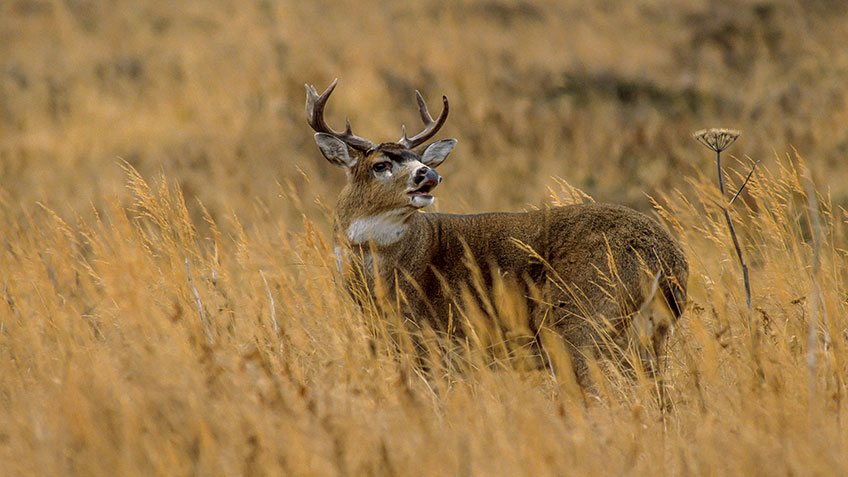
Pulling that trigger was perhaps the last thing I did correctly during my first day on Kodiak Island. The 8-point, though dead on his feet, hobbled another 60 yards before stopping. Another hit and he was secured within view. With more than an hour of good light left, we made quick work of a few photo opportunities, gutted the buck and had a debate that would very quickly come back to bite hard. The stream and cliff face we needed to reach to get down to the beach was only a few hundred yards away as the crow flies. We had two options: kill even more daylight quartering and deboning this deer to pack out, or tie a rope around its rack and start that exercise routine I’d been talking about for months, reaching (I hoped) the beach not too long after our scheduled arrival. The choice was simple, and we made the wrong one.
Who could have known that three hours later, instead of celebrating success with cold cans on the boat, I’d be lying on my back in a calf-deep pool of icy water shrouded by jagged rocks and misery, the beam from my headlamp illuminating the small stream cascading off my chest. Steve doesn’t drink, and therefore doesn’t carry the extra 12-pack around his waist that I do. He had managed to slow his forward momentum enough to keep my light in his rearview, but at this point all I knew was that he, along with the hindquarters of my deer, was somewhere down the slope ahead of me. Heck, he was probably already at the beach, doing push-ups to kill the time. If I could’ve called for help, I doubt he’d have heard it anyway over the sound of the babbling brook I was now swimming in. But it didn’t matter. The tumble I had just taken over a 3-foot waterfall emptied my lungs of air. With nothing better to do, I leaned forward and took a drink.
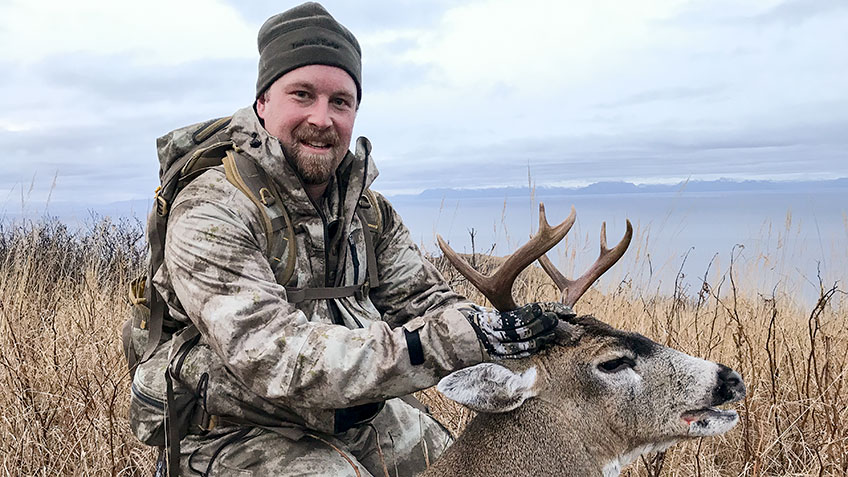
Now that I was somewhat hydrated, it was painfully clear in just about every inch of my body that the decision to float the front half of my buck down the small mountain stream was a poor one. It was par for the course. I’d made mistakes nearly from the get-go in a place that doesn’t tolerate mistakes very well and was now paying the price. The point of no return had been passed long ago, and I have to admit, the reality of my plight in such bear-thick country was beginning to scare me.
We’d hit our first snag, quite literally, shortly after reaching the first dead end in the maze we’d chosen as the “quickest” route. It seems blacktail racks and the native vegetation combine to make some of the sturdiest hook-and-loop this world has ever seen. A call to the patent office would have to wait—it was time to regroup.
Truth be told—and I only admit this because self-deprecation makes for one heck of a story angle—I truly believe that God saw the catastrophe that was about to unfold had we continued that drag, and with pity in mind, He presented the impenetrable wall of tangle so thick that it would force us to rethink our poorly devised plan. It did force us to stop and think, but rather than bust out the game bags and start the de-boning process, we simply cut the deer in half. One full circle behind the rib cage and we’d divided the load in two. Genius. Or so we thought.
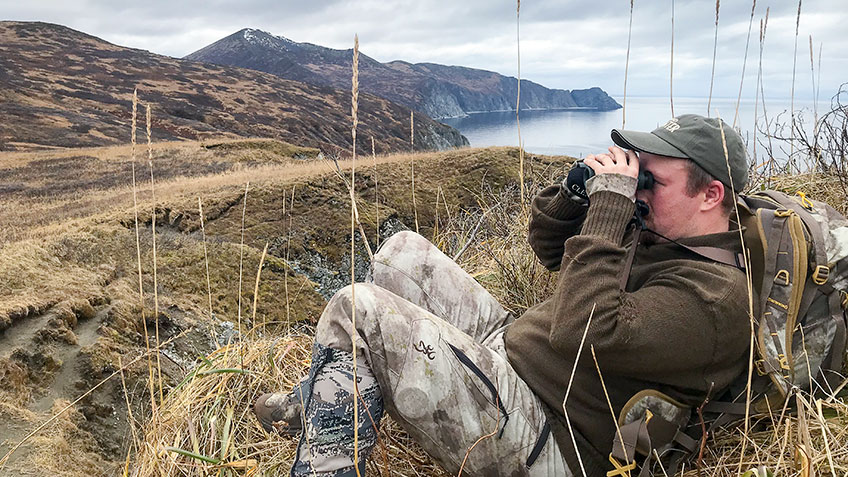
Steve must have handled that bottom half all right, but antlers were still attached to my half, and my pace in the increasingly dark night, though a bit easier on the back, wasn’t much faster than before. When I finally reached the stream, it was a limited-view situation. I could see only what my headlamp illuminated—that, and the distant glow of Steve’s light moving slowly toward the beach.
The half-rack of blacktail I’d been struggling to drag for the last few hundred yards had been leaving what I was sure was its own trail of flesh, disgust and scent—bread crumbs that even Gretel couldn’t miss, let alone the nose of a Kodiak brown bear. Taking it any slower was not an option. Using the fast-moving current to ferry the load sounded like a great idea, and for a little while it was. But with a body cavity full of water that buck became an out-of-control submarine attached to a 200-pound dope on a rope. And over the waterfall I went.
I’d like to say that despite being soaking wet, tired beyond imagination, bruised and bleeding, I climbed out of that waterfall and made it the last hundred yards down to the beach without any more blunders, and in fact, I did—well, almost.
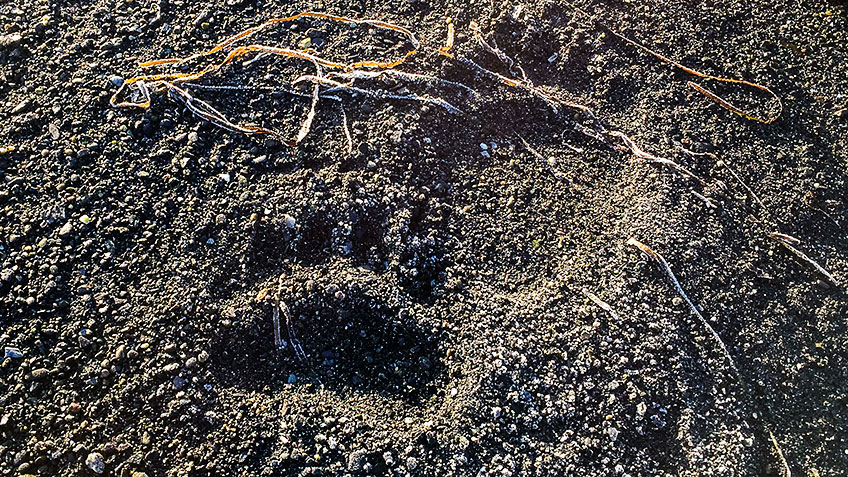
Lying in that pool, for the first time in my life I was in a position to truly contemplate giving up. But of course, despite where one may think his limit lies, in such a scenario that line fades faster than an Alaska sun in winter. There was still a little more left in my tank. I harnessed what I could muster with an angry determination and began to check movement in my extremities. Each toe wiggled “hello” and nothing felt broken—except for my ego, drive and spirit—so I rose from the drink.
If I died—which was still a very real possibility as far as I was concerned, one that was increasing with every minute that passed—it wouldn’t be because I gave up. Hell no. I pulled my submerged pack from the stream, slung it over my shoulder with strength from some unknown reservoir within, looked toward my waterlogged trophy with a crippling self-loathing and grabbed the pull rope. A quick scan of my immediate surroundings revealed a still bear-free environment, though I was sure one was closing the distance. With no alternative, I put one foot in front of the other.
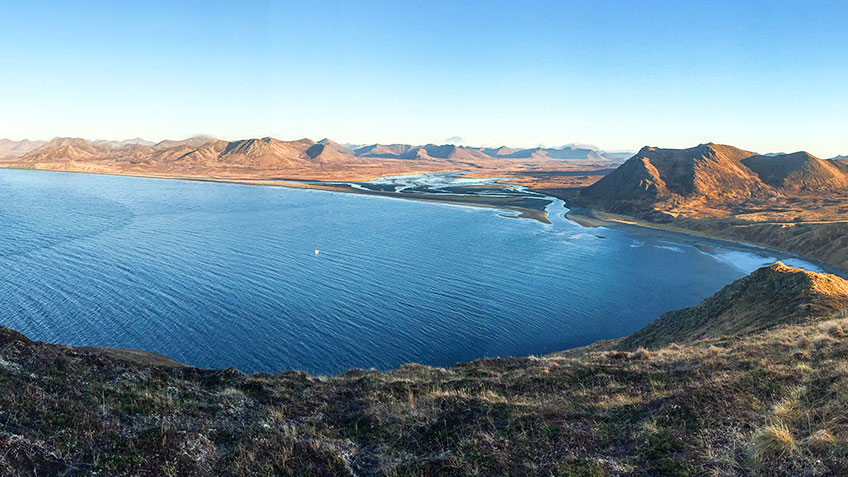
When I reached the base of the creek, the lights from Steve and Brandon were again visible as they scanned the beach for my arrival. With relief almost near, I threw myself onto the moss-covered bank for a rest-and-reflection moment and reached over my shoulder to remove my rifle and pack. With a terrible sinking feeling, I grasped twice more at the cold, empty air. There was no rifle where a rifle definitely should have been. I could have died right there.
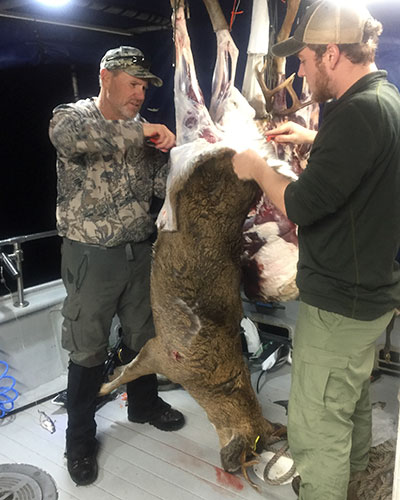 The way Steve tells it, he and Brandon had quite the time discussing why, when I seemed so close to the finish line, they were now watching the light from my headlamp slowly work its way back up the cliff. Though I contemplated the conversation that would follow had I returned to the boat and denied any recollection of ever carrying a rifle on this trip, I deduced that selling Steve on the story that he, and not I, was the one who shot the buck would be a stretch, even in his exhausted state. And so, after cursing the heavens, I crawled my way on crippled knees back up the miserable, now certainly bear-laden slope I had just traversed in search of my rifle. I found it lodged in the mud at the base of the waterfall, the reflection of my headlamp dancing through the small stream of water cascading off the scope’s objective glass.
The way Steve tells it, he and Brandon had quite the time discussing why, when I seemed so close to the finish line, they were now watching the light from my headlamp slowly work its way back up the cliff. Though I contemplated the conversation that would follow had I returned to the boat and denied any recollection of ever carrying a rifle on this trip, I deduced that selling Steve on the story that he, and not I, was the one who shot the buck would be a stretch, even in his exhausted state. And so, after cursing the heavens, I crawled my way on crippled knees back up the miserable, now certainly bear-laden slope I had just traversed in search of my rifle. I found it lodged in the mud at the base of the waterfall, the reflection of my headlamp dancing through the small stream of water cascading off the scope’s objective glass.
Why DIY
Despite the rough day-one experience, I woke the next morning in the top bunk of the Sundy, the 50-foot boat that was our floating home for the week, with a strong back and a renewed outlook. Captained by Garret Lambert of Ninilchik Charters, along with Brandon Kosht as first mate and cook, the Sundy would take us from Larsen Bay around the coast of Kodiak, stopping along the way to fish for halibut and salmon, and to hunt for Sitka blacktail, ducks and fox.
While the duck, fish and fox would be had with the aid of experience ala Capt. Garret, we’d be on our own for the deer. Ninilchik Charters is not a big-game guide service; it is a transport service only. Despite our efforts to coerce the hot locations, Garret and Brandon were not permitted to assist us on our deer hunt in any way. Alaska law prohibited them from any discussion as to where or when to hunt; they could not dress, skin or pack out any kills; they could not process meat. They were transporters only.
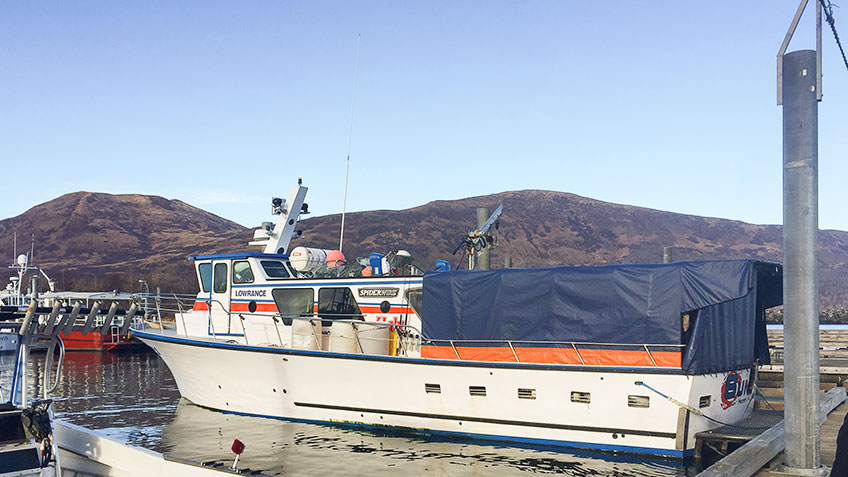
Aside from being ideal for the hunter looking to venture off on his own and set his own pace, this type of setup saves hunters the cost of paying for a guide on a trip that already racks up the bills with travel alone. But be forewarned: A DIY Kodiak hunt is not for the timid and takes the wherewithal of experience to make it through to the end. But in that end, tags filled or not, it’s the type of hunt that delivers personal fulfillment in every sense of the word.
Success or failure sat on our own shoulders. Lucky for me—and also Rick and Andrew Murphy, the father and son team that booked the two other bunks on the Sundy for the weeklong trip—Steve McGrath, VP of marketing and PR for Browning boot, sock and apparel maker SPG, had boarded the Sundy with maps and waypoints gleaned from a past hunt on the island. So despite the lack of a guide, we had the makings to find success. We’d just have to rely on our own mettle to bring it back out.
A Bearable Duck Hunt
I’d like to say the closest I got to a brown bear during my week on Kodiak was on the day Steve shot his buck. We’d climbed to the top of the highest peak in a secret, buck-laden cove where all remaining hunters would eventually fill tags. (The seldom-hunted area soon earned the nickname “Oprah’s Bay” due to its giving nature: You get a buck, and you get a buck, and you get a buck!) Soon we spotted a giant sow with a train of cubs on a beach more than a mile away. We watched as the bears slowly sauntered in the opposite direction and disappeared into the distance, and felt at ease with our decision to stray from prior lessons in packing out meat in favor of the rope and sheer force. This time, though, we made the journey with relative ease. Oprah’s Bay, as they say, is so very generous. At any rate, in hindsight I believe duck hunting brought me the closest to what surely would have been an unpleasant meeting with the true top hunter on Kodiak.
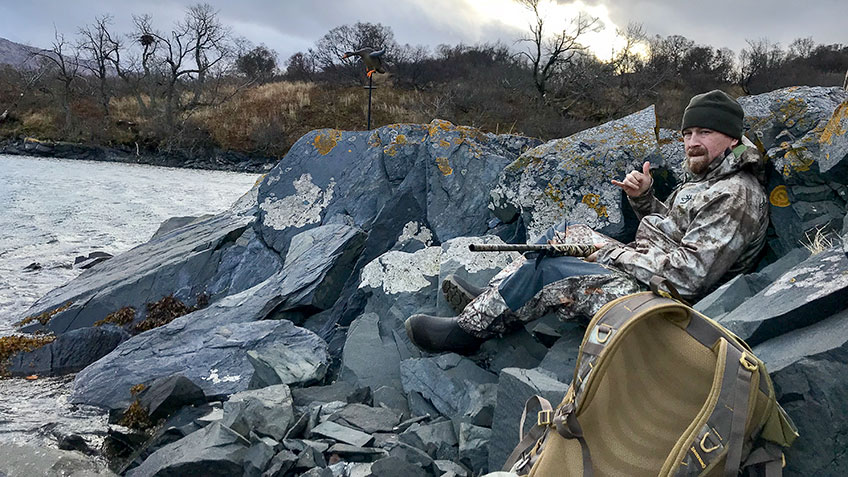
“Got a good hole for the morning, if you guys want to go.” The proposal from Garret didn’t require debate. Rain, sleet, hail or snow, waterfowl hunting gets my engine revving. If a bad hole was worth a few-hour sit in duck-shy Virginia, then the prospect of taking a single Barrow’s goldeneye or harlequin was enough for a sit in Kodiak’s worst. Good idea? I think so.
Five men with five guns and 10 eyes watched the sun rise above one of the most beautiful little duck ponds God ever created, in one of the most dangerous places on Earth. Not a bad protection detail to have on Kodiak Island. And we shot some ducks: teal and a few mallards. The only problem, realized uselessly in hindsight, of course: our eyes were glued to the sky, our barrels pointed toward water, and our backs, the one place we needed to watch, were turned blindly to the bush the entire time. Genius. Reminds me of a phrase: “as useless as teats on a bull.” Here were five boobs, all loaded for duck in bear country.
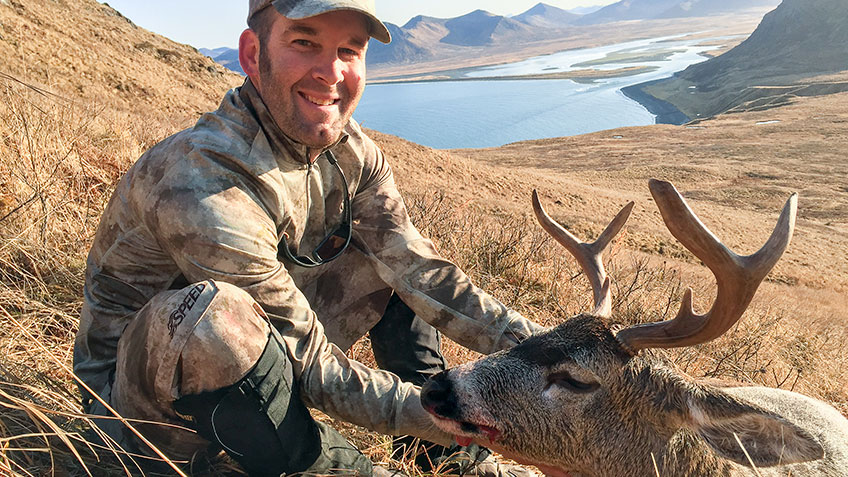
Thank the heavens we never saw that bear. Based on the size of prints we discovered only feet from our little makeshift duck blinds—prints that were presumably laid in the wet sand during the wee hours prior to our arrival—it was a whopper. I’ll try to remember the hindsight for next time.
A Fox Tale
Fox are covered under your deer tag in Alaska, and a nonresident hunter can take two during a season. Did I mention the Kodiak subspecies also happens to be one of the largest and most brilliantly colored red fox you can find, ranging from red and gray to black and silver? It doesn’t get any better than that. And so, despite what you may now believe having read the above stories, saying yes to a fox hunt was truly the only decision I made on this trip without thinking.
The hunt itself was a fairly simple endeavor. On top of fishing for halibut, we’d been completing most of our on-board activities, including hanging and butchering deer, on the open, yet covered rear deck of the Sundy. The slop bucket, where scraps of fish were tossed along with the fat and feet of six deer, was nearly full and starting to stink. Bait was plentiful. Once we dropped the increasingly putrid pile onto a nice piece of beach, all we had to do was sit back in the cozy cabin of the Sundy with binos and wait.
Sure enough, it wasn’t more than an hour before the first fox was sighted, buried muzzle deep in white fat. The plan—and yes, it played out in perfect fashion—was to hop into the Zodiac, shotgun in hand, and head toward a spot a hundred yards or so up from the bait to beach the boat. Once on land, I’d ninja-walk along the shore, hugging the cliff face until the last possible moment, at which point I’d jump around the protruding rock, level my shotgun at an unsuspecting fox mere yards away and bag myself a beauty.
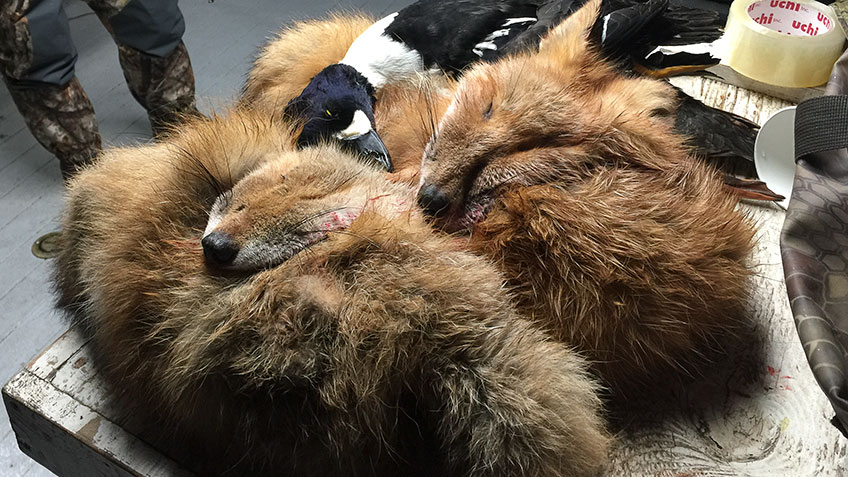
Like I said, the plan played out perfectly, with only one flaw: The fox heard me coming. Lucky for me, I had two extra rounds of No. 1 buckshot in the tube and a proclivity for swinging shotguns. He didn’t stand a chance.
The second fox scenario played out in much the same fashion, except this time we didn’t bother to beach the boat. Instead, we pointed the nose directly at him, cut the engine 75 yards from the beach, and drifted into shore in silence. Wouldn’t you know it, that curious fox came right to us.
So where is the “near-death” experience in this seemingly flawless adventure you ask? Well, let’s just say that it wasn’t my job to tie off the Zodiac once we returned to the Sundy. Despite where the fault may lie, whether the tender boat was tied-off poorly or not at all, it was already 30 yards and sailing when we noticed it disappearing into the darkness. Being at anchor, the Sundy wasn’t going to swing around to get it any time soon. Losing the Zodiac was a real possibility, and would have ended our hunt, as it was the sole vehicle used to get us from one adventure to the next.
Garret had to have been close to hypothermia when he hopped back on board. Blue-faced and teeth chattering like a hillbilly playing the spoons, he tossed the rope to Brandon and shivered his way across the deck and into the hot shower already steaming in the wash closet.
Thinking about it now, as he stripped down to his skivvies, I didn’t fully grasp what Garret was about to do until he hollered to start the shower and leapt into the darkness. Even the splash sounded cold, and without the spotlight glued to him, he’d have been swimming blind. With a water temperature around 45 degrees, he didn’t have much time. I half expected him to sink like a crab pot, the shock of the initial cold rendering his swimming skills useless. But he didn’t. Instead, he swam faster than any man alive, leaving a wake behind him that would have choked Michael Phelps. Once close to the boat, he exploded from the water like a porpoise, pulled a half-gainer and landed with the tiller in hand. Well, not really. He did swim darn fast, though. But watching Garret struggle to pull himself from the water and onto the Zodiac, well, let’s just say those painful 30 seconds were some of the longest of our lives. While we never would have asked him to risk it all, Garret did, and in doing so he saved our hunt. Close enough for you?
In Stitches
Garret and Brandon had worked hard for us over the week. We couldn’t have asked for a better crew, or better companions to spend time with in such close quarters. And so, after all paying clients had filled their deer tags, Garret slowly worked up the courage to request an afternoon off. With pockets full of their own tags, and a back deck full of deer that required butchering, it wasn’t even a question.
With our blessings and good tidings, both eventually set off—one at a time of course—and bagged nice deer. And wouldn’t you know it, after each of them successfully dropped deer, both hunters wisely butchered, deboned and packed out their meat. Go figure. The one snag—because of course, there’s got to be at least one—was that Garret came back with more than one type of blood on his hands.
If you don’t already know it, those replaceable “surgical blade” knives are surgical sharp. It’s one product about which advertisers don’t have to lie. And when you’re wrist deep in warm blacktail, well, it can be hard to distinguish finger from fascia. With griz sign nearby fresh enough to warrant haste, it was almost bound to happen.
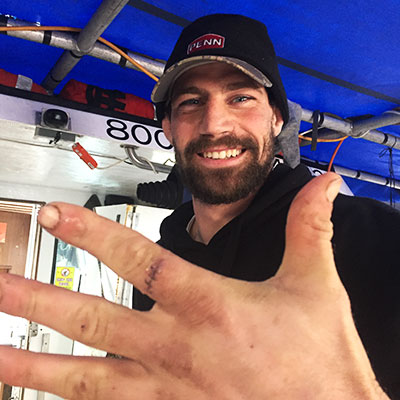
Though Garret was willing to let Mother Nature and a butterfly bandage handle this one, we all took a look and agreed that a few sutures were probably in order. And that was ideal because, despite having no one on board with anything more than Neosporin-based medical training, I had desperately always wanted to give someone stitches, and Garret was willing.
“Steve, get me some gloves and two shots of whisky. Go ahead and get one for Garret, too.”
Okay, perhaps it’s a stretch to call that a near-death experience. Yet I could argue that had I done a horrible job sewing him up, the cut could have gotten really, really infected. And had the boat’s stash of antibiotics somehow been cast overboard in the aftermath of an iceberg strike, with our remaining fuel now spilling from the large gash in the hull, it’s possible, though highly unlikely, that I would have had to add the words “finger amputation” under the word “stitches” (now with a line through it, of course) to my list of successfully performed medical procedures. My years of tutelage under Dr. Milton Bradley tell me that one would be what we in the business like to call a high-risk, nose-blinking operation. Without antibiotics or the fuel to get some, I’d eventually have to take the arm. From there it’s anyone’s guess and beyond my training. We’d be cutting it close, close to death.
Turns out Garret said they were the best stitches he’s ever had. And it’s damn good to know I can perform the task if needed.
The Send Off
So how do you cap off an adventure like this? Our week as Kodiak pirates was coming to an end. The five guys I’d sailed with, hunted with, ate with and spilled blood with would all be returning to their respective homes in places far from here. We needed a proper send-off. And so we got drunk—crab-drunk, that is.
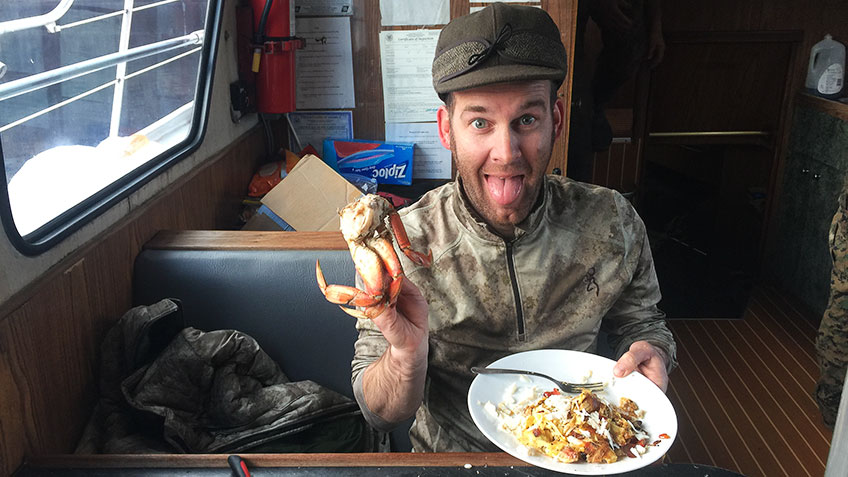
Like a final departing gift, the Kodiak waters that had been so kind to us offered up one last bounty. After soaking for a few hours while we took one last crack at waterfowl, the pots we pulled contained more deliciously sweet Dungeness crabs than we could eat. The last night on the boat was bittersweet. Devouring claws like the fat guy at the buffet, we relived the week as sounds of laughter and jubilation echoed from the Sundy across the empty black water. Though we knew we couldn’t change time, a desperate effort to prolong the inevitable was evident in all. We kept the conversations rolling as long as we could, but eventually the rolling waves and the bunks of the Sundy called to each of us one last time.
For weeks after, I’d wake to the feeling of phantom rolling waves. And for one blessed moment believe that I’d open my eyes to the sights and sounds of limitless adventure and near-death experiences.
Outfitted by Browning
I know of only one company that can truly claim the ability to outfit a hunter with everything from boots to camo, and of course, guns and ammo: Browning.
Fairly new to Browning’s apparel line, the 400G Buck Shadow boots were rugged enough to fend off the abusive vegetation, plenty stiff to provide support for nearly vertical climbs, 100 percent waterproof thanks to a breathable OutDry membrane and light enough to hunt comfortably all day.
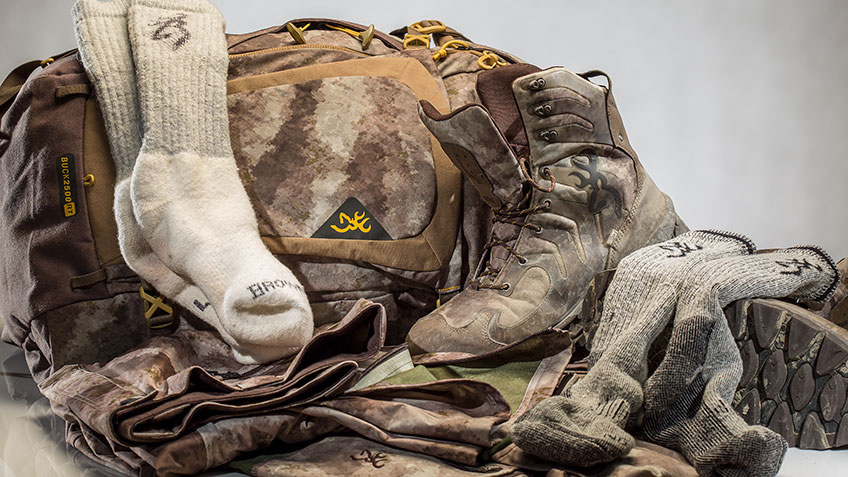
Despite the waterproof boots, a few creek crossings and one waterfall provided the opportunity to test almost every pair of socks to ever wear the Browning Buckmark. Two pairs stand out as Kodiak winners. The merino wool Redwood sock is perfect for all-season wear. It’s not too heavy, and yet is super soft, warm, moisture-wicking and odor-reducing. When temps drop, adding a pair of thick Big Bertha socks, made from a merino wool/acrylic/nylon blend, will keep the chill out while providing cushion and support.
Browning Hell’s Canyon Speed apparel in the A-Tacs AU camo pattern not only provided protection from the harsh Kodiak elements, but it matched the terrain almost perfectly. When the weather can change from a sunny 70 degrees to bitter cold with wind and rain during the course of a day, the three-ply waterproof and packable Rain Slayer Jacket and Pant were essential in my pack. Lightweight and not overly baggy, the softshell Backcountry Pant and Vest marry a durable, water-resistant shell to a soft and quiet stretch-fleece liner for added warmth.
To haul all that gear over terrain as unforgiving as Kodiak’s we shouldered the Browning Buck 2500 Hunting Daypack. It’s durable and adjustable for comfort, and its padded shoulder and waist straps don’t bind or dig in; 2,500 cubic inches of storage space, an easy-access roll top and accessory pockets throughout round out this 3.25-pound pack.

Guns and Ammo
Rifle: Browning Hell’s Canyon Speed X-Bolt in .300 WSM; MSRP: $1,269.99
Ammo: Browning BXC 185-grain Controlled Expansion; MSRP: $44.99 per 20-rnd. box
Shotgun: Browning Maxus, 12-gauge; MSRP: $1,559.99
Ammo: Browning BXD Waterfowl Extra Distance, 3-inch, No. 2; MSRP: $19.99 per 25-rnd. box.












